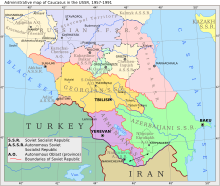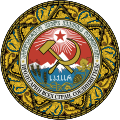Georgian Soviet Socialist Republic
| საქართველოს საბჭოთა სოციალისტური რესპუბლიკა Грузинская Советская Социалистическая Республика |
|||||
| Georgian Soviet Socialist Republic | |||||
|
|||||
| Official language | officially none; de facto Georgian and Russian | ||||
| Capital | Tbilisi | ||||
| surface | 69,700 km² | ||||
| population | 4,337,600 | ||||
| Population density | 62 inhabitants per km² | ||||
| Time zone | UTC + 3 | ||||
The Georgian Soviet Socialist Republic (abbreviation GSSR as reverse translation from Russian also Grusinische Soviet Socialist Republic called, Georgian საქართველოს საბჭოთა სოციალისტური რესპუბლიკა [ sɑkʰɑrtʰvɛlɔs sɑbt͡ʃ'ɔtʰɑ sɔt͡sɪɑlɪstʊrɪ rɛsp'ʊblɪk'ɑ ]; Russian Грузинская Советская Социалистическая Республика ) was dated 25 February 1921 to the declaration of independence on 1 April 1991 a union republic of the Soviet Union . The capital was Tbilisi (officially Tbilisi from 1936 ). On November 15, 1990, it was renamed the Georgian Republic .
development

The Georgian SSR was established after the Red Army invaded the Democratic Republic of Georgia in the spring of 1921. From 1922 to 1936 it was part of the Transcaucasian SFSR . From its dissolution in 1936 to 1991, the Georgian SSR was a union republic of the Soviet Union . Georgia was the only Soviet republic whose constitution provided for an official language, Georgian . Many Georgians were executed during the reign of Joseph Stalin . Lavrenti Beria became the first secretary of the Central Committee of the Communist Party of Georgia, and Bogdan Kobulov was its interior minister.
Administrative division
In the territory of the Georgian SSR there were three subjects settled by ethnic minorities who had a special administrative status. These were
- the Abkhaz Autonomous Soviet Socialist Republic (today corresponds to the disputed Republic of Abkhazia )
- the Adjarian Autonomous Soviet Socialist Republic (corresponds today to the Adjara Autonomous Republic within Georgia) and
- the South Ossetian Autonomous Region (today corresponds to the controversial South Ossetia )
economy
The Georgian SSR was considered the Union republic with the best living conditions. Western observers called the country the "Switzerland of the Caucasus". The subtropical climate enabled a rich harvest of agricultural products. Georgia was almost the sole supplier of citrus fruits and tea in the USSR . Georgian wine found strong sales. The area under vines rose from 58,000 to 128,000 hectares between 1950 and 1985. Annual wine production was 800,000 tons in the mid-1980s. Cattle were raised in the west of the country and sheep in the east . The tourism flourished: on the Black Sea coast and in the mountains arose holiday homes and sanatoriums. Well-known holiday resorts were Sukhumi , Gagra , Pizunda , Borjomi and Bakuriani . After the Second World War, the heavy and armaments industries expanded .
A distinctive feature of the Georgian economy was the personal secondary economy . Half of the agricultural production was private. 70% of the total and 30% of the citrus harvest was provided by the non-government sector. The productivity of the private sector has always been well above that of the state-owned companies. Outward signs were an increased density of private motor vehicles in Georgia and the intensive travel activity of Georgian farmers who brought their goods to the markets of Russian cities by air.
The second World War
When World War II reached the northern Caucasus region, Georgia was heavily influenced by the war. Of the approximately 750,000 Georgians actively involved in the war, 300,000 died. The economy was very weak, deliveries to Russia were canceled and there was a shortage of skilled workers, the conversion to the arms industry weakened economic output by 20%. Only after the war in 1947 could the conditions from the pre-war years be achieved, with the help of German prisoners of war the infrastructure was restored.
literature
- Clemens Martin: Georgia and the founding of the USSR. University of Munich, Master's thesis, Munich 1981.
- R. Abramowitsch , W. Suchomlin, I. Tseretelli : The terror against the socialist parties in Russia and Georgia. Dietz, Berlin 1925.
- Avtandil Menteshashvili: Stalin and Georgia 1924. In: Georgica. Volume 17 (1994), pp. 39-46.
- Fridtjof Nansen : People betrayed. A study trip through Georgia and Armenia as High Commissioner of the League of Nations. Brockhaus, Leipzig 1928.
- Constantin Kandelaki: The Georgian Question before the Free World. Acts - Documents - Evidence . Paris 1953.
- Charles H. Fairbanks Jr .: Clientilism and Higher Politics in Georgia 1949-1953 . in: RG Suny (Ed.): Transcaucasia. Nationalism and Social Change . Ann Arbor 1983, pp. 339-368.
- Jürgen Gerber: Georgia: National opposition and communist rule since 1956 . Nomos-Verlagsgesellschaft, Baden-Baden 1997, ISBN 3-7890-4763-5 .
- Marie-Carin von Gumppenberg: The Caucasus. History-culture-politics. In: Udo Steinbach (Ed.): The Caucasus. Publishing house CHBeck oHG, Munich 2008.
Web links
Individual evidence
- ↑ Geronti Kikodze (1954) Notes of a Contemporary, first published in 1989, Mnatobi, Issue 1, Tbilisi, Georgia.


